Free Form Structural
Design
Home > Free Form Structural
Design
Free Form Structural
Design
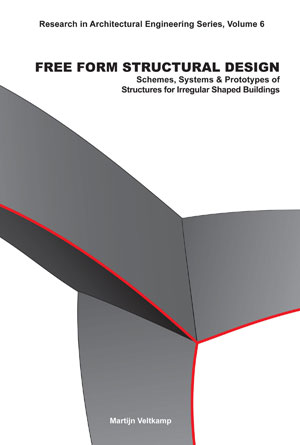
Schemes, systems and prototypes of structures for
irregular shaped buildings
Martijn Veltkamp
Irregularly shaped building designs with surfaces curving in two
directions ('double curved'), and also known as Free Form, Blob or liquid
architecture, have gained renewed interest in the last decade due to the
then emerging availability and user-friendliness of computerized design
tools in the 1990's. These tools were introduced in the domain of
architectural design through a technology transfer from film-, car and
aeroplane industry. Whereas architects explored the tools' formal
consequences and proposed building designs with them, the disciplines
involved in the technical realisation of such building designs underwent
little change, as they focussed on digitising their existing working
methods. This has resulted in structural designs which, despite fulfilling
the functional and structural requirements, are not perceived as fully
satisfying by the engineering disciplines. Notable shortcomings are the
non-conforming of structural shape and architectural shape (e.g. straight
beams in a curved building), the structure's inability to anticipate the
locally required load bearing capacity, and finally the low level of
systemisation, which for instance impedes re-using details in a customised
manner.
This observed lacking defined the primary research
question of this thesis: What are the most appropriate structural
schemes, structural systems and structural designs for free form (parts
of) buildings? 'Appropriate' is defined here as the highest
degrees of systematisation, formal freedom and material efficiency, while
'schemes', 'systems' and 'structural designs' are three levels of
abstraction, from merely abstract to highly specified. Through these
transitory steps, solutions to be developed may initially be
material-independent, thus keeping the range of applications
wide.
To answer the research question, three domains out of
numerous influential parameters have been targeted specifically:
1. The
definition of the structure's geometry;
2. The applied material and
how it is brought into shape;
3. The structural action through which
loads are transferred.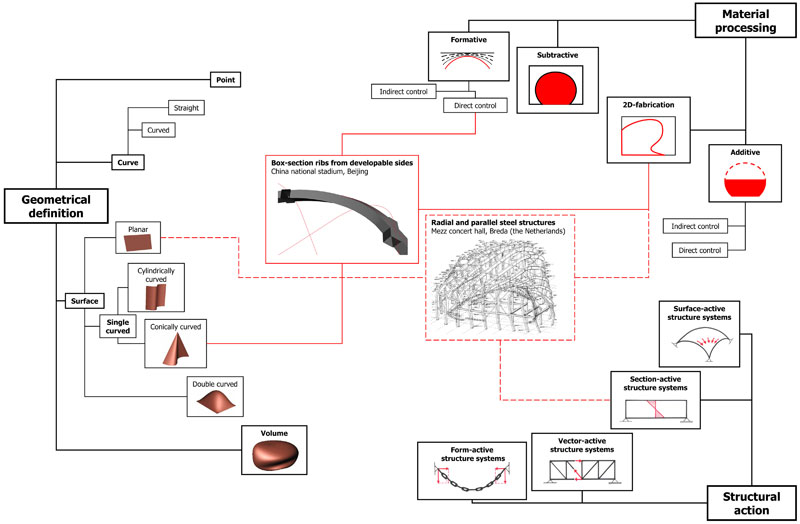
A
study of precedent projects, structures and systems addressing
sub-solutions on these three domains has resulted in the definition of
search directions for structures that meet the requirements. The three
most important potential solutions that have contributed to the final
three systems were:
1. The use of planar elements, whose contours in
plan are not constrained by manufacturing techniques;
2. The usage of
developable surfaces. These surfaces can be unrolled to a plane without
tearing or wrinkling, thus allowing use of commonly available sheet-like
materials;
3. The use of partially controlled techniques to form
materials. This means that to for instance curve a flat panel, only the
position of a few points should be secured, while the rest of the panel
settles itself in between. This greatly simplifies the fabrication of such
panels.
Several variables per potential solution, as well as
multiple values that this variable can take, were defined. By varying on
them, the potential solutions, and their combinations, were systematically
explored. As the potential solutions are inherently related to one or more
aspects of geometry, structural action or the processing of a material
class, the 23 highly abstract structural schemes that resulted, were
technically viable.
The next step comprised the development of
three structural schemes into structural systems, namely the systems:
| Planar members with end-connections, comprising a polygonal network of custom-cut timber members of variable height, while connections are kept simple by joining only two members at a time; | 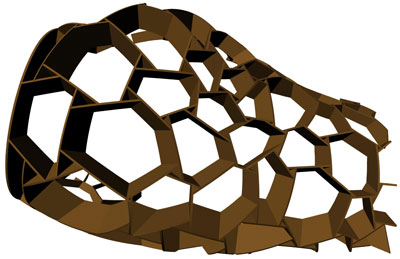 |
| Deltaribs, comprising a network of curving and
twisting members. Its members are triangular in cross section, and
are composed of custom-cut steel sheets that are rolled into a
single curved shape; |
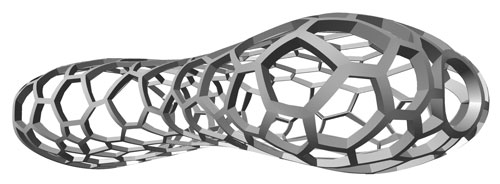 |
| 3D components, comprising prefabricated structural elements that are both structure and building envelope. They are based on a curved frame following the same principle as the Delta Ribs system, while the space in between is filled in with a structurally-active layer, which fixates the frame underneath. | 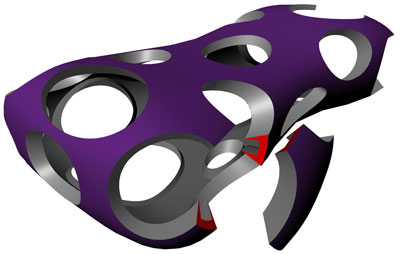 |
All systems consist of medium-sized elements that allow the system to
locally anticipate the building shape. By doing so it has been
demonstrated how the geometrical setup of the schematic setup are
propagated to a system design which comprises a specific material and a
method to process it, continually maintaining the system's technical
viability. To assess the ability to apply the system in a systematic
manner, and validate its versatility in an irregular shaped building
design, each system has been implemented on an imaginary building design.
The application in a specific context resulted in findings on the systems'
limitations.
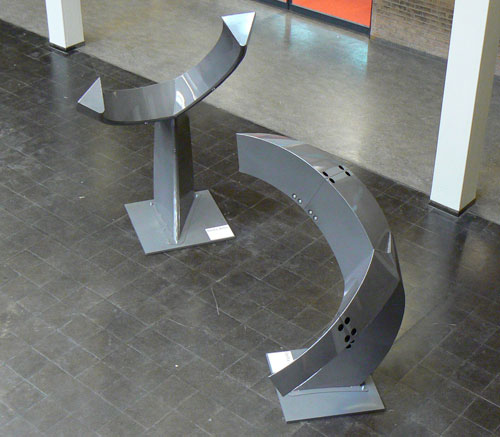 | |
| Prototypes of Deltaribs. |
This study demonstrates how structures consisting of systematically generated components fulfil the needs for structures appropriate for free form building designs. The systems resulting from this research give unprecedented freedom of shaping, while maintaining rational fabrication standards. This can be implemented through parametric modelling, in which systems adapt themselves to the local geometry, as well as to local structural needs. Technically speaking, structures of irregularly shaped buildings no longer need to be constructed as 2-dimensional frames that slice through a building with total disregard of the building's geometry.
Martijn Veltkamp
Free Form Structural Design
Schemes, Systems & Prototypes of Structures for Irregular Shaped Buildings
Research in Architectural Engineering Series. Imprint: Delft University Press. pp. 187.
ISBN: 978-1-58603-781-9
The book can be ordered with the publisher, or via any (online-)bookstore worldwide.
A no-print pdf is available from the library of Delft University of Technology.
Copyright 2011 Martijn Veltkamp, MoreThanStructures. All rights reserved. Contact.